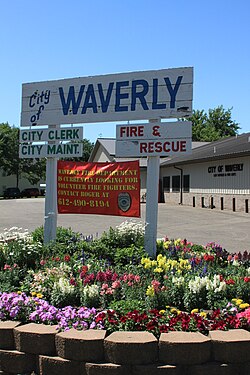History
The framework for the City of Waverly began in 1855, when the territorial legislature passed an act organizing Wright County. Shortly thereafter, the government sent out a survey team to plot the county's divisions. The surveyors were greeted by established homesteaders who had already begun clearing the land and planting crops. Before European settlement, Waverly was predominantly Big Woods, with a mixture of oak, maple, basswood and hickory. Small portions of wet prairie existed on Waverly Lake's eastern edge and along the western edge of present-day CSAH 8.
Impressed by the two lakes (Waverly and Little Waverly), available water power and the proximity of the Crow River, an entrepreneurial surveyor and his partners constructed a dam, sawmill, and grist mill in 1856 at the outlet of Little Waverly Lake. The settlement known as Waverly Mills began to take shape as approximately 300 acres were surveyed and platted. Waverly Mills's name came deom a community in Tioga County, New York, the former home of one of the partners. After a rough start with a bank panic, financial crash, and grasshopper infestations, Waverly Mills survived. Its milling industry helped establish a store, post office, and log church with a cemetery at this location.
The village was formerly called Waverly Station to distinguish it from Old Waverly, a pioneer village that had flourished about a mile away. Waverly Station was laid out by the railroad company on its land in the southwest quarter of section 33 around the time regular trains began operating there in 1868. A railroad station was erected that year, and a grain house in 1869. The first store was opened by T. R. Barrett, who operated it for a few years, then changed it to a hotel called the Keystone House.
Among the local lodges in the early 1900s were the Knights of Columbus, the Catholic Order of Foresters, the Modern Woodmen of America, the Modern Brotherhood of America, the Ancient Order of United Workmen, and the Royal Neighbors of America.
The school that once stood where Humphrey Elementary now stands was built in 1905 out of brick. It was two stories high, with a basement, and run by four teachers. In addition to a standard curriculum, the school taught manual training and music.
Waverly Station was incorporated as a village in 1881; it was reincorporated as Waverly in 1885. The following notation appears in the county records: "March 16, 1885. A special election called by the trustees of the village of Waverly for the purpose of ascertaining by ballot whether the village of Waverly should continue as the incorporated under a special act of the legislature or become reincorporated under the General Statute of Minnesota, was held on Monday, March 16, 1885. Due notice of said election having been given and the object of said election having been fully set forth in notices, polls opened at 10 a. m. and closed at 4 p. m. Number of votes polled, 41; for reincorporation, 41; against, none. The village of Waverly was therefore declared reincorporated under the General Statutes of Minnesota and same recorded in the village records." [6]
Waverly's prosperity in its early days was due to both railroad traffic and patronage of the settlers in nearby Woodland and Marysville Townships. Many of these early farmers hailed from various parts of the U.S., French Canada, Sweden, Ireland, Germany, Prussia, Austria, and Switzerland. They supported Waverly's many institutions, including a post office, bank, newspapers, city hall, churches, creamery, school, grain elevators, flouring mills, saw mill, insurance agencies, hotels, livery stables, general stores, hardware dealers, furniture shops, lumber companies, bakery, meat markets, millinery shops, saloons, and a drugstore.
Waverly moved faster and progressed farther in 30 years than some of its rival communities. Some say that Waverly's businesses and buildings were some of Wright County's largest and finest at their height of development. According to one historical account, Waverly was "a pleasant, prosperous village, located on one of the very pleasant lakes; it is quite a summer resort for pleasure seekers". Records indicate that by 1909, its population had grown to over 1,000.
Since its incorporation, Waverly has changed both physically and demographically. Like many similar rural Minnesota communities, Waverly has felt the socioeconomic effects of industrialized agriculture, with an exodus of young residents to regional urban cores and an aging population. Waverly hosted some small development in the 1930s and '40s and a small subdivision in the early 1960s. But by 1980, its population had decreased to 470. Direct results of this rural trend were merging, consolidating, and vanishing institutions and businesses.
Researchers have found that small communities like Waverly are entering a period of transition and metamorphosis. The grain elevators that once identified Waverly are gone, and new residential housing developments have appeared. The Twin Cities metropolitan area, once seemingly distant, is a 40-minute drive away.
From 2000 to 2007, Waverly attracted a flurry of attention from residential developers. The influx of new residents during this period recalled Waverly's historical boom period before 1900. But this time, the growth was primarily housing. Several developments were platted, including Summerfields, Woodland Shores, Spring Meadows, Carrigan Meadows, Carrigan Estates, and Windgate at Carrigan Lake. The population increased by over 60% from 2000 to nearly 1,300 in 2010 after many decades without growth. Waverly is now poised for continued growth while maintaining its small-town appeal. [7]
The Waverly Village Hall, built in 1939, is listed on the National Register of Historic Places. [8]


